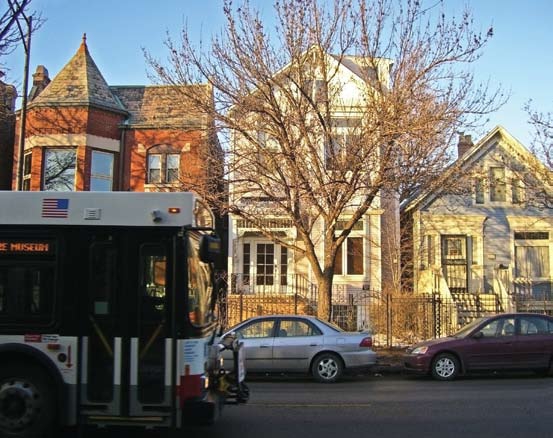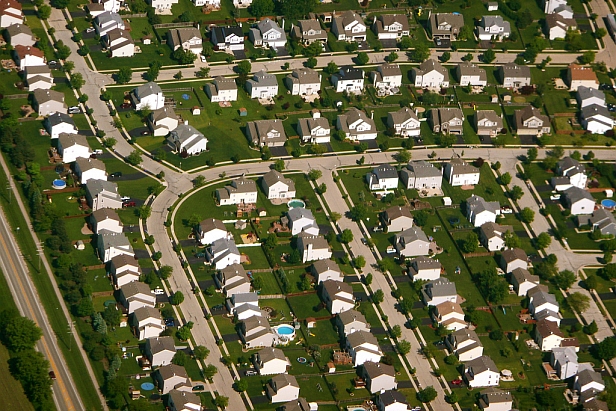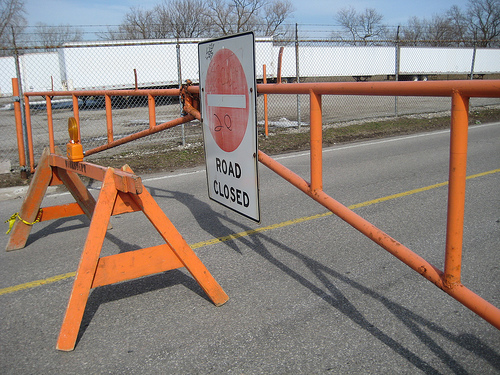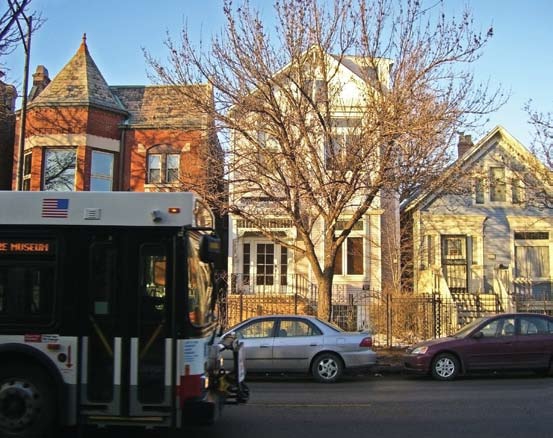 A transit-served Chicago neighborhoodPhoto: Jennifer Henry/NRDCLet’s say you want to live in one of those fancy Smart Growth developments that green urbanists are always going on about. Let’s say you want to live in any neighborhood with transit service and a grid that encourages walking and biking.
A transit-served Chicago neighborhoodPhoto: Jennifer Henry/NRDCLet’s say you want to live in one of those fancy Smart Growth developments that green urbanists are always going on about. Let’s say you want to live in any neighborhood with transit service and a grid that encourages walking and biking.
Great. Living in a walkable, transit-connected neighborhood can save you money on gas and car maintenance, and maybe even eliminate the need for a car altogether. But it will cost you too, because housing in dense areas is pricier on average than housing in spread-out suburbs.
Mortgage lenders could help make walkable urban homes more attainable by offering location-efficient mortgages (more on those later) — but it would take a concerted effort from the Obama administration to make it happen.
The problem
The auto-dependent suburban housing style has dominated the nation’s home construction for the last … oh, six decades. But research suggests only about half of Americans want to live in those subdivisions. A 2004 National Association of Realtors survey [PDF] found that 55 percent of respondents said they would prefer to live in Smart Growth-style neighborhoods rather than suburban ones. So while the supply of new housing in compact urban areas is low, demand is high.
“When you look at the supply side, even a town like Seattle has at best 10 percent of its housing stock in a walkable urban environment,” said Christopher Leinberger, a University of Michigan real-estate scholar and the author of The Option of Urbanism. “You’ve got huge pent-up demand and that pushes up prices.”
He’s found that walkable urban properties, on a square-foot basis, cost between 40 and 200 percent more than suburban homes.
Denizens of walkable neighborhoods could make up some of that difference by saving on car expenses. Consider that households in traditional suburbs spend 24 percent of their income on transportation costs, according to the Center for Neighborhood Technology, while households in walkable urban areas spend only 16 percent.
A potential solution
What if mortgage lenders took into account the potential financial benefits of living in compact, mixed-used neighborhoods? Homeowners who spend less on gasoline — or don’t even own a car — have more money left for their housing payments. That should make them more attractive bets for lenders.
That’s the thinking behind the location-efficient mortgage, a largely unproven tool that encourages buying in walkable urban neighborhoods by making it easier to qualify for mortgages there.
“It creates more buying power,” said David Goldstein, co-director of the Natural Resources Defense Council’s energy program and a longtime advocate of place-based mortgages. “If you want to live in some place that has moderate density and good transit, this will enable you to afford a home.”
 The kind of housing we’ve been buildingPhoto: Scorpians and Centaurs via FlickrWith a conventional mortgage, a lender assesses a borrower’s ability to repay by comparing a household’s expected housing costs to its income (and considering factors such as credit score). But that misses a big chunk of expenses: transportation spending, which accounts for 19 percent of a household’s budget, on average.
The kind of housing we’ve been buildingPhoto: Scorpians and Centaurs via FlickrWith a conventional mortgage, a lender assesses a borrower’s ability to repay by comparing a household’s expected housing costs to its income (and considering factors such as credit score). But that misses a big chunk of expenses: transportation spending, which accounts for 19 percent of a household’s budget, on average.
Location-efficient mortgages add the costs of owning, maintaining, and insuring cars to the equation. They rely on the pioneering work of Chicago’s Center for Neighborhood Technology, which is seeking to modernize thinking about housing affordability with its Housing + Transportation Affordability Index, which measures the “true cost” of housing (its web app is fun to explore).
Forthcoming research in The Journal of Sustainable Real Estate suggests a link between higher mortgage default rates and sprawling, auto-dependent areas. In the study “Location Efficiency and Mortgage Default,” researchers looked at more than 40,000 mortgages in the Chicago, Jacksonville, and San Francisco metro regions, which have all struggled with higher-than-average foreclosure rates. They found that areas with high rates of vehicle ownership tended to have higher default rates when adjusted for income disparities.
The research, sponsored and promoted by NRDC, isn’t perfect, because vehicle ownership rates are a crude proxy for location efficiency. Still, it provides a useful early look at the connection between sprawl and foreclosures, which has received surprisingly little data-driven scrutiny.
“Anecdotally, we’ve seen that foreclosure rates in the last two years have been higher in the farther-flung suburbs,” said Joe Molinaro, who advises local governments for the National Association of Realtors. “There’s a lot more studying that could be done on that.”
NRDC’s Goldstein argues that place-based mortgages could reinvigorate both the construction and the home-loan industry.
“Sprawl-style development is virtually at a halt right now because there are too many houses on the market,” he said. “The only places that would support expanded housing development are in location-efficient areas. Changing these underwriting rules is the only tool we have right now to help the housing industry to recover. You would think that would get someone’s attention.”
Could it work?
Place-based mortgages have been tested out in several pilot programs, dating back to 1994. But they suffered from poor advertising and produced tiny samples — a program in Chicago attracted 41 buyers and one in Massachusetts involved 72. Of course, getting a mortgage wasn’t exactly difficult during the housing bubble.
“When [the pilots] were tried, there wasn’t a real need for them,” said Molinaro. “Until two years ago, you could pretty much write your own mortgage.”
The demonstration projects also failed to determine whether the incentives actually changed anyone’s behavior. If buyers were going to buy the same home anyway, the mortgages weren’t accomplishing anything. To be truly effective and help people buy into neighborhoods they might not otherwise be able to afford, location-efficient mortgages may need to offer not just lower qualifying standards but also lower interest rates — something the model hasn’t previously included.
“It’s not necessarily a great selling point to say that with a location-efficient mortgage you can have a larger debt,” said Molinaro.
Another issue: Increasing consumers’ borrowing power can drive up prices, raising questions about affordability and gentrification. Goldstein argues that location-efficient mortgages discourage gentrification by helping
renters in walkable neighborhoods become buyers. But if more people are competing for a limited stock of housing, that can mean rising prices.
“It would be a mistake to do this without an affordable housing strategy,” said housing journalist Alyssa Katz, author of Our Lot: How Real Estate Came to Own Us.
Advocates did learn one thing from the pilots: To be widely used, location-efficient mortgages had to be part of lenders’ standard offerings. If they remained a niche product, few buyers (and even lenders) would be aware of them.
Making it happen
As the Obama administration looks to reform the troubled housing-finance industry, it could make location-efficient mortgages part of its overhaul.
On Aug. 17, the administration will hold a conference on fixing the housing-finance system, and by January it will put forth a proposal for reforming Fannie Mae and Freddie Mac, the government-sponsored companies that guarantee about half the mortgages in the U.S. The admin could require Fannie and Freddie to incorporate location efficiency into their lending criteria, a change that would ripple out to mortgage lenders across the country.
Housing and Urban Development Secretary Shaun Donovan is already sympathetic to Smart Growth, and his department now considers location efficiency as it makes some grants. “It’s time the federal government stopped encouraging sprawl,” Donovan told the Congress for the New Urbanism in Atlanta this spring.
But the president’s economic team may not be willing to promote any new ideas that could spook the skittish housing and mortgage markets. As Katz notes, when Donovan [PDF] and Treasury Secretary Timothy Geithner [PDF] submitted their objectives for federal housing policy in the spring, they affirmed traditional goals such as home ownership and affordability but made no mention of sustainability or efficiency.
“That tells me there’s a strong political constituency around just preserving the existing — and very important — functions of Fannie and Freddie in whatever comes next,” Katz said. “It’s going to be a real fight, potentially, to get anything new on the agenda.”
Risky new options have little chance of figuring in the overhaul. But location efficiency isn’t risky; it’s prudent. By giving a fuller picture of a household’s true costs, the model could protect buyers and lenders both.
In the meantime, more Americans are discovering that living in walkable neighborhoods can be more affordable than they assumed. We can hope that will continue with or without lending reforms.



